Optical microscope

The optical microscope, also referred to as a light microscope, is a type of
The object is placed on a stage and may be directly viewed through one or two eyepieces on the microscope. In high-power microscopes, both eyepieces typically show the same image, but with a stereo microscope, slightly different images are used to create a 3-D effect. A camera is typically used to capture the image (micrograph).
The sample can be lit in a variety of ways. Transparent objects can be lit from below and solid objects can be lit with light coming through (
A range of objective lenses with different magnification are usually provided mounted on a turret, allowing them to be rotated into place and providing an ability to zoom-in. The maximum magnification power of optical microscopes is typically limited to around 1000x because of the limited resolving power of visible light. While larger magnifications are possible no additional details of the object are resolved.
Alternatives to optical microscopy which do not use visible light include
Types
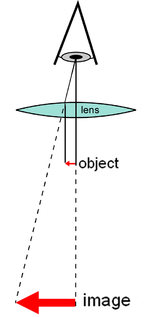
There are two basic types of optical microscopes: simple microscopes and compound microscopes. A simple microscope uses the optical power of a single lens or group of lenses for magnification. A compound microscope uses a system of lenses (one set enlarging the image produced by another) to achieve a much higher magnification of an object. The vast majority of modern research microscopes are compound microscopes, while some cheaper commercial digital microscopes are simple single-lens microscopes. Compound microscopes can be further divided into a variety of other types of microscopes, which differ in their optical configurations, cost, and intended purposes.
Simple microscope
A simple microscope uses a lens or set of lenses to enlarge an object through angular magnification alone, giving the viewer an erect enlarged virtual image.[1][2] The use of a single convex lens or groups of lenses are found in simple magnification devices such as the magnifying glass, loupes, and eyepieces for telescopes and microscopes.
Compound microscope

A compound microscope uses a lens close to the object being viewed to collect light (called the
Other microscope variants
There are many variants of the compound optical microscope design for specialized purposes. Some of these are physical design differences allowing specialization for certain purposes:
- Stereo microscope, a low-powered microscope which provides a stereoscopic view of the sample, commonly used for dissection.
- Comparison microscope has two separate light paths allowing direct comparison of two samples via one image in each eye.
- Inverted microscope, for studying samples from below; useful for cell cultures in liquid or for metallography.
- Fiber optic connector inspection microscope, designed for connector end-face inspection
- Traveling microscope, for studying samples of high optical resolution.
Other microscope variants are designed for different illumination techniques:
- Petrographic microscope, whose design usually includes a polarizing filter, rotating stage, and gypsum plate to facilitate the study of minerals or other crystalline materials whose optical properties can vary with orientation.
- Polarizing microscope, similar to the petrographic microscope.
- Phase-contrast microscope, which applies the phase contrast illumination method.
- Epifluorescence microscope, designed for analysis of samples that include fluorophores.
- Confocal microscope, a widely used variant of epifluorescent illumination that uses a scanning laser to illuminate a sample for fluorescence.
- Two-photon microscope, used to image fluorescence deeper in scattering media and reduce photobleaching, especially in living samples.
- Student microscope – an often low-power microscope with simplified controls and sometimes low-quality optics designed for school use or as a starter instrument for children.[4]
- light scattering to allow viewing of tiny particles whose diameter is below or near the wavelength of visible light (around 500 nanometers); mostly obsolete since the advent of electron microscopes
- Tip-enhanced Raman microscope, is a variant of optical microscope based on tip-enhanced Raman spectroscopy, without traditional wavelength-based resolution limits.[5][6] This microscope primarily realized on the scanning-probe microscope platforms using all optical tools.
Digital microscope
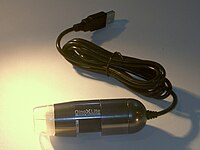
A digital microscope is a microscope equipped with a digital camera allowing observation of a sample via a computer. Microscopes can also be partly or wholly computer-controlled with various levels of automation. Digital microscopy allows greater analysis of a microscope image, for example, measurements of distances and areas and quantitation of a fluorescent or histological stain.
Low-powered digital microscopes,
Digital microscopy with very low light levels to avoid damage to vulnerable biological samples is available using sensitive
History
Invention
The earliest microscopes were single
Compound microscopes first appeared in Europe around 1620[9][10] including one demonstrated by Cornelis Drebbel in London (around 1621) and one exhibited in Rome in 1624.[11][12]
The actual inventor of the compound microscope is unknown although many claims have been made over the years. These include a claim 35
Galileo Galilei is sometimes cited as a compound microscope inventor. After 1610, he found that he could close focus his telescope to view small objects, such as flies, close up[19] and/or could look through the wrong end in reverse to magnify small objects.[20] The only drawback was that his 2 foot long telescope had to be extended out to 6 feet to view objects that close.[21] After seeing the compound microscope built by Drebbel exhibited in Rome in 1624, Galileo built his own improved version.[11][12] In 1625, Giovanni Faber coined the name microscope for the compound microscope Galileo submitted to the Accademia dei Lincei in 1624 [22] (Galileo had called it the "occhiolino" or "little eye"). Faber coined the name from the Greek words μικρόν (micron) meaning "small", and σκοπεῖν (skopein) meaning "to look at", a name meant to be analogous with "telescope", another word coined by the Linceans.[23]
Christiaan Huygens, another Dutchman, developed a simple 2-lens ocular system in the late 17th century that was achromatically corrected, and therefore a huge step forward in microscope development. The Huygens ocular is still being produced to this day, but suffers from a small field size, and other minor disadvantages.
Popularization

Antonie van Leeuwenhoek (1632–1724) is credited with bringing the microscope to the attention of biologists, even though simple magnifying lenses were already being produced in the 16th century. Van Leeuwenhoek's home-made microscopes were simple microscopes, with a single very small, yet strong lens. They were awkward in use, but enabled van Leeuwenhoek to see detailed images. It took about 150 years of optical development before the compound microscope was able to provide the same quality image as van Leeuwenhoek's simple microscopes, due to difficulties in configuring multiple lenses. In the 1850s, John Leonard Riddell, Professor of Chemistry at Tulane University, invented the first practical binocular microscope while carrying out one of the earliest and most extensive American microscopic investigations of cholera.[25][26]
Lighting techniques
While basic microscope technology and optics have been available for over 400 years it is much more recently that techniques in sample illumination were developed to generate the high quality images seen today.
In August 1893,
The
Fluorescence microscopy
Modern biological microscopy depends heavily on the development of
Since the mid-20th century chemical fluorescent stains, such as
Components
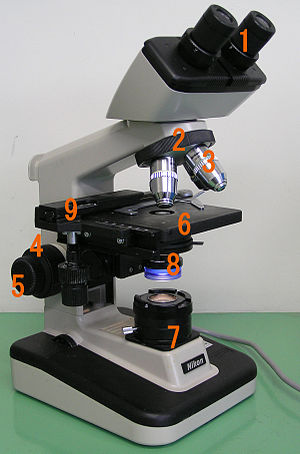
All modern optical microscopes designed for viewing samples by transmitted light share the same basic components of the light path. In addition, the vast majority of microscopes have the same 'structural' components[27] (numbered below according to the image on the right):
- Eyepiece (ocular lens) (1)
- Objective turret, revolver, or revolving nose piece (to hold multiple objective lenses) (2)
- Objective lenses (3)
- Focus knobs (to move the stage)
- Coarse adjustment (4)
- Fine adjustment (5)
- Stage (to hold the specimen) (6)
- Light source (a light or a mirror) (7)
- Diaphragm and condenser(8)
- Mechanical stage (9)
Eyepiece (ocular lens)
The eyepiece, or ocular lens, is a cylinder containing two or more lenses; its function is to bring the image into focus for the eye. The eyepiece is inserted into the top end of the body tube. Eyepieces are interchangeable and many different eyepieces can be inserted with different degrees of magnification. Typical magnification values for eyepieces include 5×, 10× (the most common), 15× and 20×. In some high performance microscopes, the optical configuration of the objective lens and eyepiece are matched to give the best possible optical performance. This occurs most commonly with apochromatic objectives.
Objective turret (revolver or revolving nose piece)
Objective turret, revolver, or revolving nose piece is the part that holds the set of objective lenses. It allows the user to switch between objective lenses.
Objective lens
At the lower end of a typical compound optical microscope, there are one or more
Oil immersion objective

Some microscopes make use of
Focus knobs
Adjustment knobs move the stage up and down with separate adjustment for coarse and fine focusing. The same controls enable the microscope to adjust to specimens of different thickness. In older designs of microscopes, the focus adjustment wheels move the microscope tube up or down relative to the stand and had a fixed stage.
Frame
The whole of the optical assembly is traditionally attached to a rigid arm, which in turn is attached to a robust U-shaped foot to provide the necessary rigidity. The arm angle may be adjustable to allow the viewing angle to be adjusted.
The frame provides a mounting point for various microscope controls. Normally this will include controls for focusing, typically a large knurled wheel to adjust coarse focus, together with a smaller knurled wheel to control fine focus. Other features may be lamp controls and/or controls for adjusting the condenser.
Stage
The stage is a platform below the objective lens which supports the specimen being viewed. In the center of the stage is a hole through which light passes to illuminate the specimen. The stage usually has arms to hold slides (rectangular glass plates with typical dimensions of 25×75 mm, on which the specimen is mounted).
At magnifications higher than 100× moving a slide by hand is not practical. A mechanical stage, typical of medium and higher priced microscopes, allows tiny movements of the slide via control knobs that reposition the sample/slide as desired. If a microscope did not originally have a mechanical stage it may be possible to add one.
All stages move up and down for focus. With a mechanical stage slides move on two horizontal axes for positioning the specimen to examine specimen details.
Focusing starts at lower magnification in order to center the specimen by the user on the stage. Moving to a higher magnification requires the stage to be moved higher vertically for re-focus at the higher magnification and may also require slight horizontal specimen position adjustment. Horizontal specimen position adjustments are the reason for having a mechanical stage.
Due to the difficulty in preparing specimens and mounting them on slides, for children it is best to begin with prepared slides that are centered and focus easily regardless of the focus level used.
Light source
Many sources of light can be used. At its simplest, daylight is directed via a
Condenser
The
Magnification
The actual power or magnification of a compound optical microscope is the product of the powers of the eyepiece and the objective lens. For example a 10x eyepiece magnification and a 100x objective lens magnification gives a total magnification of 1,000×. Modified environments such as the use of oil or ultraviolet light can increase the resolution and allow for resolved details at magnifications larger than 1,000x.
Operation
Illumination techniques
Many techniques are available which modify the light path to generate an improved
- Four examples of transilumination techniques used to generate contrast in a sample of tissue paper. 1.559 μm/pixel.
-
Bright field illumination, sample contrast comes from absorbanceof light in the sample.
-
Cross-polarized light illumination, sample contrast comes from rotation of polarized light through the sample.
-
scatteredby the sample.
-
interferenceof different path lengths of light through the sample.
Other techniques
Modern microscopes allow more than just observation of transmitted light image of a sample; there are many techniques which can be used to extract other kinds of data. Most of these require additional equipment in addition to a basic compound microscope.
- Reflected light, or incident, illumination (for analysis of surface structures)
- Fluorescence microscopy, both:
- Epifluorescence microscopy
- Confocal microscopy
- Microspectroscopy (where a UV-visible spectrophotometer is integrated with an optical microscope)
- Ultraviolet microscopy
- Near-Infrared microscopy
- Multiple transmission microscopy[29] for contrast enhancement and aberration reduction.
- Automation (for automatic scanning of a large sample or image capture)
Applications
Optical microscopy is used extensively in microelectronics, nanophysics, biotechnology, pharmaceutic research, mineralogy and microbiology.[30]
Optical microscopy is used for
In industrial use, binocular microscopes are common. Aside from applications needing true
Measuring microscopes are used for precision measurement. There are two basic types. One has a
Very small, portable microscopes have found some usage in places where a laboratory microscope would be a burden.[36]
Limitations

At very high magnifications with transmitted light, point objects are seen as fuzzy discs surrounded by diffraction rings. These are called Airy disks. The resolving power of a microscope is taken as the ability to distinguish between two closely spaced Airy disks (or, in other words the ability of the microscope to reveal adjacent structural detail as distinct and separate). It is these impacts of diffraction that limit the ability to resolve fine details. The extent and magnitude of the diffraction patterns are affected by both the wavelength of light (λ), the refractive materials used to manufacture the objective lens and the numerical aperture (NA) of the objective lens. There is therefore a finite limit beyond which it is impossible to resolve separate points in the objective field, known as the diffraction limit. Assuming that optical aberrations in the whole optical set-up are negligible, the resolution d, can be stated as:
Usually a wavelength of 550 nm is assumed, which corresponds to
Surpassing the resolution limit
Multiple techniques are available for reaching resolutions higher than the transmitted light limit described above. Holographic techniques, as described by Courjon and Bulabois in 1979, are also capable of breaking this resolution limit, although resolution was restricted in their experimental analysis.[38]
Using fluorescent samples more techniques are available. Examples include
Despite significant progress in the last decade, techniques for surpassing the diffraction limit remain limited and specialized.
While most techniques focus on increases in lateral resolution there are also some techniques which aim to allow analysis of extremely thin samples. For example, sarfus methods place the thin sample on a contrast-enhancing surface and thereby allows to directly visualize films as thin as 0.3 nanometers.
On 8 October 2014, the
Structured illumination SMI
SMI (spatially modulated illumination microscopy) is a light optical process of the so-called point spread function (PSF) engineering. These are processes which modify the PSF of a microscope in a suitable manner to either increase the optical resolution, to maximize the precision of distance measurements of fluorescent objects that are small relative to the wavelength of the illuminating light, or to extract other structural parameters in the nanometer range.[42][43]
Localization microscopy SPDMphymod
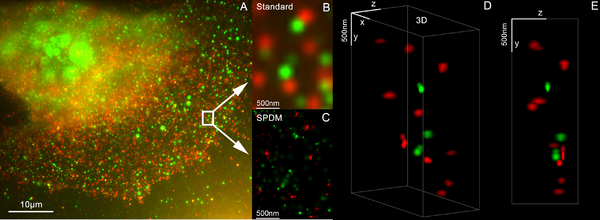
SPDM (spectral precision distance microscopy), the basic localization microscopy technology is a light optical process of
Many standard fluorescent dyes like GFP, Alexa dyes, Atto dyes, Cy2/Cy3 and fluorescein molecules can be used for localization microscopy, provided certain photo-physical conditions are present. Using this so-called SPDMphymod (physically modifiable fluorophores) technology a single laser wavelength of suitable intensity is sufficient for nanoimaging.[48]
3D super resolution microscopy
3D super resolution microscopy with standard fluorescent dyes can be achieved by combination of localization microscopy for standard fluorescent dyes SPDMphymod and structured illumination SMI.[49]
STED
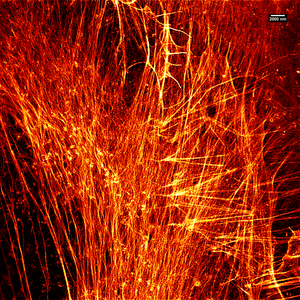
Alternatives
In order to overcome the limitations set by the diffraction limit of visible light other microscopes have been designed which use other waves.
- Atomic force microscope(AFM)
- Scanning electron microscope (SEM)
- Scanning ion-conductance microscopy (SICM)
- Scanning tunneling microscope (STM)
- Transmission electron microscopy (TEM)
- Ultraviolet microscope
- X-ray microscope
It is important to note that higher frequency waves have limited interaction with matter, for example soft tissues are relatively transparent to X-rays resulting in distinct sources of contrast and different target applications.
The use of electrons and X-rays in place of light allows much higher resolution – the wavelength of the radiation is shorter so the diffraction limit is lower. To make the short-wavelength probe non-destructive, the atomic beam imaging system (
STM and AFM are scanning probe techniques using a small probe which is scanned over the sample surface. Resolution in these cases is limited by the size of the probe; micromachining techniques can produce probes with tip radii of 5–10 nm.
Additionally, methods such as electron or X-ray microscopy use a vacuum or partial vacuum, which limits their use for live and biological samples (with the exception of an
See also
References
- ^ JR Blueford. "Lesson 2 – Page 3, CLASSIFICATION OF MICROSCOPES". msnucleus.org. Archived from the original on 10 May 2016. Retrieved 15 January 2017.
- ISBN 978-81-317-6147-2.
- ^ ISBN 978-0-521-43591-8.
- ^ "Buying a cheap microscope for home use" (PDF). Oxford University. Archived (PDF) from the original on 5 March 2016. Retrieved 5 November 2015.
- PMID 30911174.
- S2CID 92998248.
- (PDF) from the original on 4 June 2016.
- ^ Atti Della Fondazione Giorgio Ronchi E Contributi Dell'Istituto Nazionale Di Ottica, Volume 30, La Fondazione-1975, page 554
- ISBN 978-90-6984-615-6.
- ^ William Rosenthal, Spectacles and Other Vision Aids: A History and Guide to Collecting, Norman Publishing, 1996, pp. 391–392
- ^ a b c Raymond J. Seeger, Men of Physics: Galileo Galilei, His Life and His Works, Elsevier - 2016, page 24
- ^ a b c J. William Rosenthal, Spectacles and Other Vision Aids: A History and Guide to Collecting, Norman Publishing, 1996, page 391
- ISBN 978-90-6984-615-6.
- ^ Van Helden, p. 43
- ISBN 0313335281.
- ^ Note: stories vary, including Zacharias Janssen had the help of his father Hans Martens (or sometimes said to have been built entirely by his father). Zacharias' probable birth date of 1585 (Van Helden, p. 28) makes it unlikely he invented it in 1590 and the claim of invention is based on the testimony of Zacharias Janssen's son, Johannes Zachariassen, who may have fabricated the whole story (Van Helden, p. 43).
- ^ Brian Shmaefsky, Biotechnology 101 - 2006, page 171
- ^ "Who Invented the Microscope?". Live Science. 14 September 2013. Archived from the original on 3 February 2017. Retrieved 31 March 2017.
- ^ Robert D. Huerta, Giants of Delft: Johannes Vermeer and the Natural Philosophers : the Parallel Search for Knowledge During the Age of Discovery, Bucknell University Press - 2003, page 126
- ^ A. Mark Smith, From Sight to Light: The Passage from Ancient to Modern Optics, University of Chicago Press - 2014, page 387
- ^ Daniel J. Boorstin, The Discoverers, Knopf Doubleday Publishing Group - 2011, page 327
- ISBN 978-0-224-05044-9.
- ^ "Il microscopio di Galileo" Archived 9 April 2008 at the Wayback Machine, Instituto e Museo di Storia della Scienza (in Italian)
- ISBN 0-609-60142-3.
- ^ Riddell JL (1854). "On the binocular microscope". Q J Microsc Sci. 2: 18–24.
- PMID 4572620.
- ^ "How to Use a Compound Microscope". Microscope.com. Retrieved 8 February 2023.
- ^ Kenneth, Spring; Keller, H. Ernst; Davidson, Michael W. "Microscope objectives". Olympus Microscopy Resource Center. Archived from the original on 1 November 2008. Retrieved 29 October 2008.
- S2CID 13366261.
- ^ O1 Optical Microscopy Archived 24 January 2011 at the Wayback Machine By Katarina Logg. Chalmers Dept. Applied Physics. 20 January 2006
- ^ "Long-focus microscope with camera adapter". macrolenses.de. Archived from the original on 3 October 2011.
- ^ "Questar Maksutov microscope". company7.com. Archived from the original on 15 June 2011. Retrieved 11 July 2011.
- ^ "FTA long-focus microscope". firsttenangstroms.com. Archived from the original on 26 February 2012. Retrieved 11 July 2011.
- ISBN 978-0-824-74252-2.
- ^ "Microscopy". Journal of the Royal Microscopical Society, Containing Its Transactions and Proceedings and a Summary of Current Researches Relating to Zoology and Botany (Principally Invertebrata and Cryptogamia), Microscopy, &c. 1906. p. 716. A discussion of Zeiss measuring microscopes.
- ^ Linder, Courtney (22 November 2019). "If You've Ever Wanted a Smartphone Microscope, Now's Your Chance". Popular Mechanics. Retrieved 3 November 2020.
- S2CID 15793849.
- .
- ^ "Demonstration of a Low-Cost, Single-Molecule Capable, Multimode Optical Microscope". Archived from the original on 6 March 2009. Retrieved 25 February 2009.
- AP News. Archivedfrom the original on 11 October 2014. Retrieved 8 October 2014.
- New York Times. Archivedfrom the original on 9 October 2014. Retrieved 8 October 2014.
- S2CID 128763403.
- ^ Cremer, Christoph; Hausmann, Michael; Bradl, Joachim and Schneider, Bernhard "Wave field microscope with detection point spread function", U.S. patent 7,342,717, priority date 10 July 1997
- S2CID 13805053.
- S2CID 55468495.
- ^ Heintzmann, R.; Münch, H.; Cremer, C. (1997). "High-precision measurements in epifluorescent microscopy – simulation and experiment" (PDF). Cell Vision. 4: 252–253. Archived (PDF) from the original on 16 February 2016.
- ^ Cremer, Christoph; Hausmann, Michael; Bradl, Joachim and Rinke, Bernd "Method and devices for measuring distances between object structures", U.S. patent 6,424,421 priority date 23 December 1996
- (PDF) from the original on 3 May 2019.
- S2CID 2119158.
- ^ "German Future Prize for crossing Abbe's Limit". Archived from the original on 7 March 2009. Retrieved 24 February 2009.
Cited sources
- Van Helden, Albert; Dupre, Sven; Van Gent, Rob (2011). The Origins of the Telescope. Amsterdam University Press. ISBN 978-9069846156.
Further reading
- "Metallographic and Materialographic Specimen Preparation, Light Microscopy, Image Analysis and Hardness Testing", Kay Geels in collaboration with Struers A/S, ASTM International 2006.
- "Light Microscopy: An ongoing contemporary revolution", Siegfried Weisenburger and Vahid Sandoghdar, arXiv:1412.3255 2014.
External links
- Antique Microscopes & Scientific Instruments A site about Antique Microscopes, their Accessories, and History
- Antique Microscopes.com A collection of early microscopes
- Historical microscopes, an illustrated collection with more than 3000 photos of scientific microscopes by European makers (in German)
- The Golub Collection, A collection of 17th through 19th century microscopes, including extensive descriptions
- Molecular Expressions, concepts in optical microscopy
- Online tutorial of practical optical microscopy at University of Cambridge
- OpenWetWare
- Cell Centered Database






